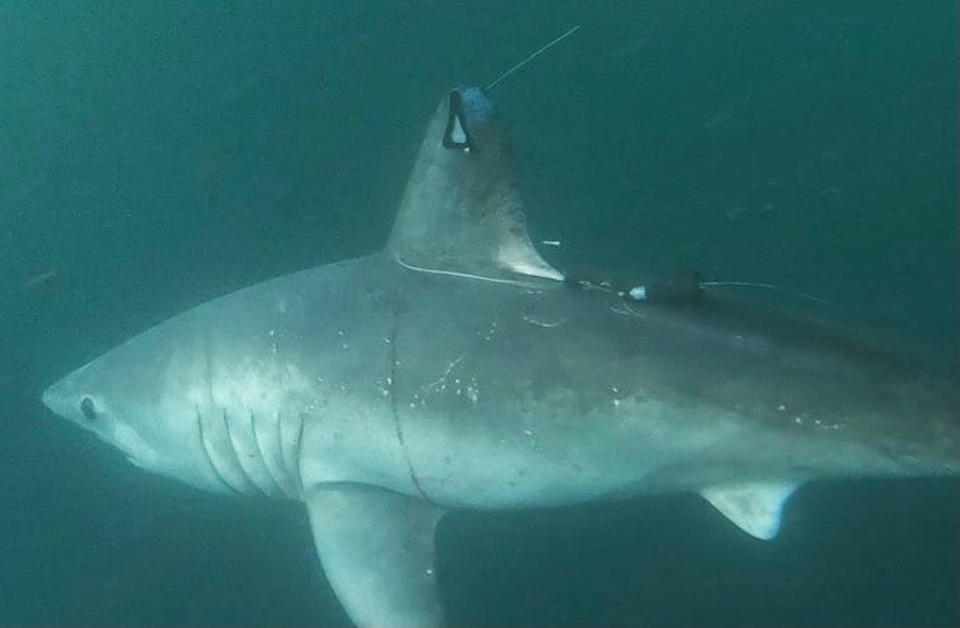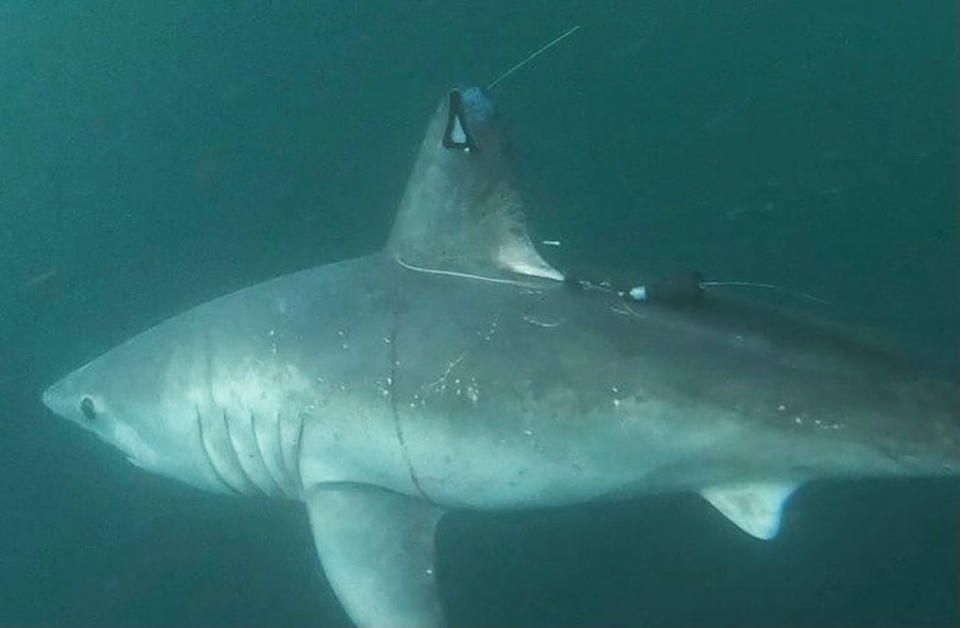Just weeks before a pregnant porbeagle shark was expected to give birth, one of the two tracker tags marine scientists had placed on the animal floated to the surface near Bermuda.
The team hadn’t expected the tag to surface for months. They had attached it to the 7-foot creature just 158 days earlier, after hoisting the shark onto a boat off the coast of Cape Cod, Massachusetts, in October 2020 and giving it an ultrasound. The pop-off tag was designed to stay on for about a year.
“Something had gone very wrong,” said Brooke Anderson, who worked as a shark researcher at Arizona State University at the time.
A second tag, which was designed to transmit a signal when the shark’s fin broke the sea surface, would never do so again.
The data from the recovered “pop-off” tag showed a curious pattern. For about five months, the depth and temperature information seemed normal for the species. Then it went haywire.
“All of a sudden, the temperature spiked, even at 600 meters depth, and stayed elevated,” Anderson said.
The creature’s diving pattern also became strange.

“All of the data pointed to the same conclusion: She had been eaten,” Anderson said.
The researchers determined that the explanation for the tag’s anomalous readings was that the device had spent several days inside the stomach of a different animal.
Anderson and her fellow researchers laid out their findings in a study published Tuesday morning in the journal Frontiers in Marine Science. It represents the first evidence of a porbeagle being eaten by something even bigger.
The study authors named a few possible killers. They narrowed down the suspects based on their biology. The tag’s temperature readings didn’t fit the profile of a mammal like an orca, for example. So the scientists centered on endothermic sharks, which have some warm-blooded capabilities.
“It had to be a shark that can elevate its body temperature above the surrounding water. It had to be large enough to do enough damage to the porbeagle, and it had to inhabit the area where the predation occurred,” Anderson said.
The researchers concluded that a white shark or shortfin mako shark must have munched on their pregnant porbeagle and ingested the tag temporarily.
“I would guess this would have been a mature female white shark, probably 15-plus feet,” Anderson said.
Before this, researchers didn’t think it was even possible that porbeagle sharks could be preyed upon, she added.
The team’s original goal was to trace pregnant porbeagle sharks throughout their pregnancy and figure out where the creatures typically go to give birth.
In total, they found and tagged 11 porbeagle sharks during two seasons in the Atlantic, hoisting each one into their boat, laying the creature out on deck, giving the shark a hose of aerated saltwater and covering its eyes with a wet towel.
“We work like a NASCAR pit crew,” Anderson said. Eight of the sharks were pregnant.
Her team never imagined they’d uncover a deep-water murder mystery.
Matt Davis, a marine resource scientist for the Maine Department of Marine Resources who was not involved in the research, said the new study’s conclusion “certainly falls within believability.”
The incident shows that scientists still have much to learn about life and predator-prey relationships in the intermediate depths of the ocean, Davis added.
Porbeagle sharks are listed as vulnerable by the International Union for Conservation of Nature because they were overfished beginning in the 1960s. By around 2001, estimates suggested the species’ population had fallen by 75% to 80%, according to Anderson.
The species is on the rebound due to fishing regulations, but recovery will take decades, if not longer, because porbeagles can live for 30 to 40 years in the Atlantic and they produce relatively few young in comparison to other species.
“We need to keep tagging and tracking these sharks to see how often this is occurring,” Anderson said of the predation. “In one instant, this already-depleted species lost not only an important reproductive female, but also all her developing pups. We need to better understand how often this is happening and how much of an impact this might have on the population.”
In the shark-eat-shark Atlantic, their research could ultimately aid the species’ return to health.
This article was originally published on NBCNews.com
EMEA Tribune is not involved in this news article, it is taken from our partners and or from the News Agencies. Copyright and Credit go to the News Agencies, email news@emeatribune.com Follow our WhatsApp verified Channel





